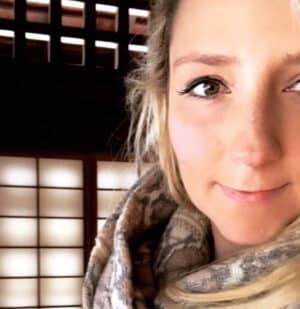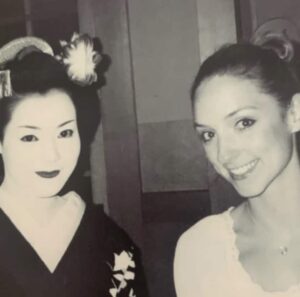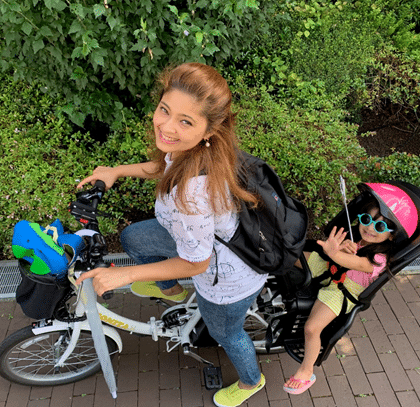
Nupur is a freelance travel writer who’s lived in Bangkok, Abu Dhabi and Dubai before moving to Tokyo in December 2018. She loves travelling with her daughter and went on a month-long solo backpacking trip to Asia in 2018 on her 30th birthday and her daughter’s 2nd birthday.
When in Japan she enjoys unraveling all corners of Tokyo with her daughter and her husband.
Currently she writes for the website “Japan Info” prior to which she has worked for several years in the marketing field with Four Seasons Hotels & Resorts to manage website content.
“The Mamachari and my family”
In a city of above 9 million population, truly there is only one transportation demigod the “Mamachari.”
Mamachari is a Japanese slang word meaning “Mama’s Chariot” or just “Mama bike” but no bias here, it really is a unisex bicycle used across all ages.
Mamachari, a model of sustainable infrastructure lesson from Japan to the world, was a head turner for me when we moved to Tokyo, especially as a Mum who has relocated here from Dubai, the world of the fast and furious 4 wheelers.
In my early days in the city, what really stood out was how, a fabulous workout could be achieved by just riding a rented bike and at the same time I could roam across many neighborhoods in Tokyo (especially if you are a tourist.) Myself, my husband and our daughter went for our first family dinner date on two rented Mamachari last December when we had just relocated to Tokyo. It was quite fun and definitely gives a sense of freedom to explore.
But once we moved in our own place, out of the hotel, we realized how much we needed our mamachari’s a day to day basis. There were distances shorter than the train journey but a tedious walk with a 2-something year-old, carrying groceries, for example, was proving to be more and more difficult.
But then our daughter needed to attend preschool which was a bit of a long walk for early mornings, so the time had come to start looking for buying a Mamachari for ourselves. Looking back now, I have to say it’s a lifeline and my daughter truly enjoys the rides and even naps comfortably at times.
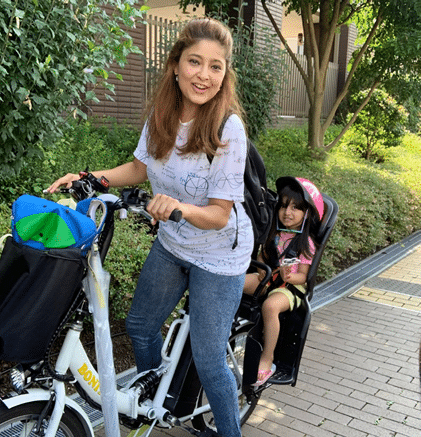
Mamacharis are so user friendly !
Riding a Mamachari definitely does not necessarily require any professional training – it’s just like any other bicycle but way easier. You don’t need any exceptional riding skills. They are for anyone and everyone. It’s absolutely nothing to be perplexed about, especially new Mamachari riders. After a few rides alone and you should be ready for the roads.
Tokyo has bicycle designated paths, making it a safer environment for the rider and child. Like some other cities, the rider does not have to ride in the car lane or bus lane, which definitely makes me feel safer when doing long distances with my daughter safely sitting behind me.
This is definitely a very well thought-of form of transportation, ergonomically designed for short distance turns, narrow lanes and it balances evenly when stacked evenly, weight wise, on both sides.
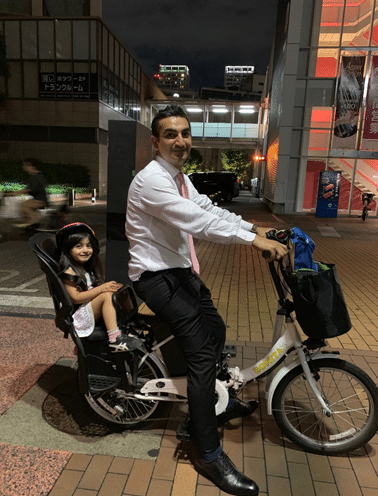
Not something I suggest doing, but the July of 2019 I saw a man riding on his Mamachari carrying a microwave, 2 dogs and a surf board in Tateyama (Chiba)! I do believe that man had his priorities right but that does say something about the Mamachari.
Designed with all the practical components, a mamachari has a shopping basket on the front mostly, but quite often you will also see an infant baby seat is adjusted ahead as well, and a toddler seat on the back. A luggage rack (the luggague rack/shopping basket is 99% at the front of the bike but there are also times when there are 2 babies sitting in front, and in such cases the shopping basket can be fitted behind.).
The general rule is babies sit in front carrier and toddlers behind.These shopping baskets/luggage racks have different models and can be adjusted based on needs just like the baby seats.(readjusted)could be in front or back, dynamo lights, a bell, a sturdy rear stand that keeps the bike upright and stable once parked, mudguards, chain guards and an integrated spoke lock. And electric bikes with gears are available in various variants and gear shift patterns. Some may also be battery included with further enhancements making it even easier a ride to cruise around the city at leisure.
I’ve also recently learned that it’s not at all unusual for a Mamachari to sport two child seats and sometimes you will spot one with space for 3.
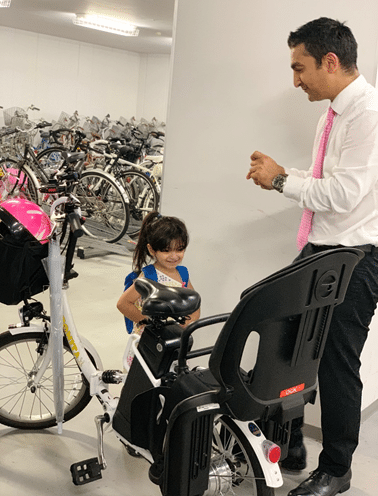
Purchasing a Mamachari
When purchasing a Mamachari I realized that you can either first buy the bicycle and then upgrade by mounting the child seats as required or you can buy a totally assembled unit with all matching parts. But after some research I felt like, cost wise, both options are almost the same unless you buy second hand bikes and play mix match.
My favourite places for second hand bikes are at garage sales, facebook groups such as Sayonara, Welcome to Tokyo, Tokyo Buy & Sell and other such similar groups online mostly from families relocating and selling at distress prices.
Keeping an eye out for a few weeks can really help you save tremendously.
There are many families and individuals putting up bikes up for sale quite frequently probably as it’s the most popular mode of transport.
If you prefer a brand new bike, I recommend BIC Camera, Amazon, Rakuten as well as neighbourhood bicycle stores.
Price wise a battery-operated geared bicycle would be JPY 35,000 – 45,000 if you grab a decent second hand model like Yamaha, Panasonic etc. and the firsthand models range somewhere from Y100,000 – Y150,000.
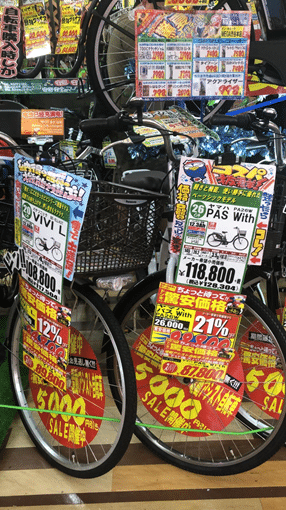
An electric bike with shift gears does not need continously paddling and definitely makes for easy crusing around town. Whereas i feel the silver lining of a non geared bike would definitely be the work out one can get out of riding one. Also it proves to be very easy on the pocket.
But if the purpose is carrying kids and belongings it does get easier with the geared option on a day to day basis.
For our Mamachari we got a decent second hand deal from a family of 3 relocating to Sweden for Y32,000 it’s called a “Bonita” and we got it registered at a nearby Koban ( police box) in Minato-Ku. This is a geared bike, battery operated and it needs to charge once every week with a total usage of around 12 kms per week. The only thing after the bike purchase that we invested in was the helmet for our daughter.
Parking, one of the biggest big-city concerns in a busy city in Tokyo, is no problem with a mamachari as there are many available options ranging from 100 yen to 150 yen for 24 hours. Most main stations usually are equipped with bicycle parking space making it convenient to travel around the city with ease and no stress of the bicycle being stolen. Ensure that you do not park the cycle in no parking zones to avoid any of those yellow tickets = fines!
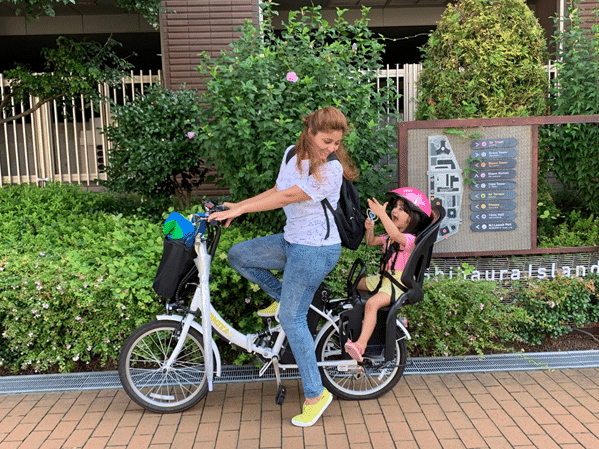
Health and culture
I have always wondered why the average Japanese person looked so fit and I am starting to think it’s a lifestyle. When riding a bike on a daily basis you don’t even realize, you are working out.
If you are wondering about the how fast a Mamachari can travel, I recommend checking out the annual Mamachari Endurance Race to test that off at the Tokachi International Speedway. It’s competitive race where you bring in your own Mamachari and dress up as Superman, Pokémon, Samurai or even a panda – basically all the heavy-duty grocery-go-getters look and it’s a race to finish.
A mamachari isn’t just for women. Many childless businessmen also have a Mamachari. It makes sense as even the men with their laptop bags and black suits appreciate the luggage rack to place their belongings or just designated space for their shopping at the end of the day.
Legend has it there is a shop now by the name “Mamachari bikes” for the Japan made lovers in London since 2013 and in Northern Tanzania people have seen to be embracing the Mamachari culture.
I really understand why many Japanese people look no further than the Mamachari.
It really does tick all the way from recreation, biking, commuting, day to day chores an absolute fabric of life.
Nupur is a freelance travel writer who’s lived in Bangkok, Abu Dhabi and Dubai before moving to Tokyo in December 2018. She loves travelling with her daughter and went on a month-long solo backpacking trip to Asia in 2018 on her 30th birthday and her daughter’s 2nd birthday. When in Japan she enjoys unraveling all corners of Tokyo with her daughter and her husband. Currently she writes for the website “Japan Info” prior to which she has worked for several years in the marketing field with Four Seasons Hotels & Resorts to manage website content.

